Urban Heat Island: Causes, Consequences, and Mitigation Measures with Emphasis on Reflective and Permeable Pavements
Abstract
:1. Introduction
2. Urban Heat Island Phenomenon
3. Contribution Factors to Urban Heat Island Formation
4. Consequences of the Urban Heat Island
4.1. Human Comfort and Health
4.2. Energy Consumption
4.3. Air Pollution and Greenhouse Gas Emission
4.4. Surface Water Quality Deterioration
5. Strategies for Mitigating UHI Effects
5.1. Reflective Pavements
5.2. Permeable Pavements
- Effectively ameliorate urban microclimate through the evaporative cooling process. Due to higher water retention capacity and higher volume of interconnected voids, they have a higher evaporation rate than other conventional pavements [71,121,123]. In urban areas with extensive impervious surfaces, low evapotranspiration rate is a major factor in increasing daytime temperatures [15].
- They can reduce energy consumption and GHG emissions by 73.48% and 46.70%, respectively [123].
6. Conclusions
Author Contributions
Funding
Institutional Review Board Statement
Informed Consent Statement
Data Availability Statement
Conflicts of Interest
References
- Ünal, Y.S.; Sonuç, C.Y.; Incecik, S. Investigating urban heat island intensity in Istanbul. Theor. Appl. Clim. 2020, 139, 175–190. [Google Scholar] [CrossRef]
- Filho, W.L.; Icaza, L.E.; Emanche, V.O.; Al-Amin, A.Q. An Evidence-Based Review of Impacts, Strategies, and Tools to Mitigate Urban Heat Islands. Int. J. Environ. Res. Public Health 2017, 14, 1600. [Google Scholar] [CrossRef] [PubMed] [Green Version]
- World Urbanisation Prospects 2012: The 2011 Revision—Highlights; United Nations Department of Economic and Social Affairs, Population Division: New York, NY, USA, 1973; Volume 7, pp. 769–779. [CrossRef]
- World Urbanization Prospects 2018: Highlights (ST/ESA/SER.A/421); United Nations, Department of Economic and Social Affairs, Population Division: New York, NY, USA, 2019.
- Perpiña Castillo, C.; Kavalov, B.; Jacobs-Crisioni, C.; Baranzelli, C.; Batista e Silva, F.; Lavalle, C. Main Land-Use Patterns in the EU within 2015–2030; JRC115895; European Commission: Brussels, Belgium, 2019. [Google Scholar]
- Tu, L.; Qin, Z.; Li, W.; Geng, J.; Yang, L.; Zhao, S.; Zhan, W.; Wang, F. Surface urban heat island effect and its relationship with urban expansion in Nanjing, China. J. Appl. Remote Sens. 2016, 10, 026037. [Google Scholar] [CrossRef] [Green Version]
- Chen, G.; Li, X.; Liu, X.; Chen, Y.; Liang, X.; Leng, J.; Xu, X.; Liao, W.; Qiu, Y.; Wu, Q.; et al. Global projections of future urban land expansion under shared socioeconomic pathways. Nat. Commun. 2020, 11, 537. [Google Scholar] [CrossRef] [PubMed] [Green Version]
- Huang, K.; Li, X.; Liu, X.; Seto, K.C. Projecting global urban land expansion and heat island intensification through 2050. Environ. Res. Lett. 2019, 14, 114037. [Google Scholar] [CrossRef] [Green Version]
- Oke, T. Towards better scientific communication in urban climate. Theor. Appl. Clim. 2006, 84, 179–190. [Google Scholar] [CrossRef]
- Imran, H.M.; Kala, J.; Ng, A.W.M.; Muthukumaran, S. Impacts of future urban expansion on urban heat island effects during heatwave events in the city of Melbourne in southeast Australia. Q. J. R. Meteorol. Soc. 2019, 145, 2586–2602. [Google Scholar] [CrossRef] [Green Version]
- Barnes, K.B.; Morgan, J.; Roberge, M. Impervious Surfaces and the Quality of Natural and Built Environments; Department of Geography and Environmental Planning, Towson University: Towson, MD, USA, 2001. [Google Scholar]
- Haselbach, L.; Boyer, M.; Kevern, J.T.; Schaefer, V.R. Cyclic Heat Island Impacts on Traditional Versus Pervious Concrete Pavement Systems. Transp. Res. Rec. 2011, 2240, 107–115. [Google Scholar] [CrossRef]
- Shuster, W.D.; Bonta, J.; Thurston, H.; Warnemuende, E.; Smith, D.R. Impacts of impervious surface on watershed hydrology: A review. Urban Water J. 2005, 2, 263–275. [Google Scholar] [CrossRef]
- Gorsevski, V.; Taha, H.; Quattrochi, D.; Luvall, J. Air pollution prevention through urban heat island mitigation: An update on the Urban Heat Island Pilot Project. Proc. ACEEE Summer Study Asilomar CA 1998, 9, 23–32. [Google Scholar]
- Taha, H. Urban climates and heat islands: Albedo, evapotranspiration, and anthropogenic heat. Energy Build. 1997, 25, 99–103. [Google Scholar] [CrossRef] [Green Version]
- Cao, L.; Li, P.; Zhang, L. Impact of impervious surface on urban heat island in Wuhan, China. In Proceedings of the International Conference on Earth Observation Data Processing and Analysis, Wuhan, China, 28–30 December 2008; Volume 7285. [Google Scholar] [CrossRef]
- Sen, S.; Roesler, J.; Ruddell, B.; Middel, A. Cool Pavement Strategies for Urban Heat Island Mitigation in Suburban Phoenix, Arizona. Sustainability 2019, 11, 4452. [Google Scholar] [CrossRef] [Green Version]
- Xu, H.; Lin, D.; Tang, F. The impact of impervious surface development on land surface temperature in a subtropical city: Xiamen, China. Int. J. Climatol. 2013, 33, 1873–1883. [Google Scholar] [CrossRef]
- Hong, J.W.; Hong, J.; Kwon, E.E.; Yoon, D.K. Temporal dynamics of urban heat island correlated with the socio-economic development over the past half-century in Seoul, Korea. Environ. Pollut. 2019, 254 Pt A, 112934. [Google Scholar] [CrossRef]
- Gray, K.A.; Finster, M.E. The Urban Heat Island, Photochemical Smog, and Chicago: Local Features of the Problem and Solution; Northwestern University: Evanston, IL, USA, 1999. [Google Scholar]
- Arifwidodo, S.; Chandrasiri, O.; Abdulharis, R.; Kubota, T. Exploring the effects of urban heat island: A case study of two cities in Thailand and Indonesia. APN Sci. Bull. 2019, 9. [Google Scholar] [CrossRef] [Green Version]
- Zeiger, S.J.; Jason, A.H. Urban Stormwater Temperature Surges: A Central US Watershed Study. Hydrology 2015, 2, 193–209. [Google Scholar] [CrossRef]
- Xie, D.M.; James, W. Modelling Solar Thermal Enrichment of Urban Stormwater. J. Water Manag. Model. 1994, 205–219. [Google Scholar] [CrossRef] [Green Version]
- Wijeyesekera, D.C.; Nazari, N.A.R.B.M.; Lim, S.M.; Masirin, M.I.M.; Zainorabidin, A.; Walsh, J. Investigation into the Urban Heat Island Effects from Asphalt Pavements. OIDA Int. J. Sustain. Dev. 2012, 5, 97–118. [Google Scholar]
- Akbari, H.; Rose, L.S. Characterising the Fabric of the Urban Environment: A Case Study of Metropolitan Chicago, Illinois; Lawrence Berkeley National Laboratory: Berkeley, CA, USA, 2001.
- Cosgrove, A.; Berkelhammer, M. Downwind footprint of an urban heat island on air and lake temperatures. NPJ Clim. Atmos. Sci. 2018, 1, 46. [Google Scholar] [CrossRef] [Green Version]
- Tan, J.; Zheng, Y.; Tang, X.; Guo, C.; Li, L.; Song, G.; Zhen, X.; Yuan, D.; Kalkstein, A.J.; Li, F.; et al. The urban heat island and its impact on heat waves and human health in Shanghai. Int. J. Biometeorol. 2010, 54, 75–84. [Google Scholar] [CrossRef]
- Shahmohamadi, P.; Che-Ani, A.; Maulud, K.; Tawil, N.; Abdullah, N. The impact of anthropogenic heat on formation of urban heat island and energy consumption balance. Urban Stud. Res. 2011, 497524. [Google Scholar] [CrossRef] [Green Version]
- Oke, T.R. Boundary Layer Climates, 2nd ed.; Routledge, Taylor and Francis Group: Cambridge, UK, 1987; p. 435. [Google Scholar]
- Georgiadis, T. Urban Climate and Risk; Oxford Handbooks Online; Oxford University Press: Oxford, UK, 2017; pp. 1–29. [Google Scholar]
- Hove, L.W.A.; Steeneveld, G.J.; Jacobs, C.M.J.; Heusinkveld, B.G.; Elbers, J.A.; Moors, E.J. Assessment Based on a Literature Review, Recent Meteorological Observations and Datasets Provided by Hobby Meteorologists. Alterra, report 2170. In Exploring the Urban Heat Island Intensity of Dutch Cities; Alterra: Wageningen, The Netherlands, 2011. [Google Scholar] [CrossRef]
- Yang, Q.; Huang, X.; Li, J. Assessing the relationship between surface urban heat islands and landscape patterns across climatic zones in China. Sci. Rep. 2017, 7. [Google Scholar] [CrossRef]
- Martin, P.; Baudouin, M.B.; Gachon, P. An alternative method to characterise the surface urban heat island. Int. J. Biometeorol. 2015, 59, 849–861. [Google Scholar] [CrossRef]
- Soltani, A.; Sharifi, E. Daily variation of urban heat island effect and its correlations to urban greenery: A case study of Adelaide. Front. Archit. Res. 2017, 6, 529–538. [Google Scholar] [CrossRef]
- Oke, T.R. The energetic basis of the urban heat island. Q. J. R. Meteorol. Soc. 1982, 108, 1–23. [Google Scholar] [CrossRef]
- Oke, T.R. The urban energy balance. Prog. Phys. Geogr. 1988, 12, 471–508. [Google Scholar] [CrossRef]
- US Environmental Protection Agency. Urban Heat Island Basics. In Reducing Urban Heat Islands: Compendium of Strategies; US Environmental Protection Agency: Washington, DC, USA, 2008. Available online: https://www.epa.gov/sites/production/files/2017-05/documents/reducing_urban_heat_islands_ch_1.pdf (accessed on 10 December 2020).
- Banya, B.; Techato, K.; Ghimire, S.; Chhipi-Shrestha, G.A. Review of Green Roofs to Mitigate Urban Heat Island and Kathmandu Valley in Nepal. Appl. Ecol. Environ. Sci. 2018, 6, 137–152. [Google Scholar]
- Núñez Peiró, M.; Sánchez-Guevara Sánchez, C.; González, F.J.N. Source area definition for local climate zone studies. A systematic review. Build. Environ. 2019, 148, 258–285. [Google Scholar] [CrossRef] [Green Version]
- Dian, C.; Pongrácz, R.; Dezső, Z.; Bartholy, J. Annual and monthly analysis of surface urban heat island intensity with respect to the local climate zones in Budapest. Urban Clim. 2020, 31, 100573. [Google Scholar] [CrossRef]
- Ziter, C.D.; Pedersen, E.J.; Kucharik, C.J.; Turner, M.G. Scale-dependent interactions between tree canopy cover and impervious surfaces reduce daytime urban heat during summer. Proc. Natl. Acad. Sci. USA 2019, 116, 7575–7580. [Google Scholar] [CrossRef] [Green Version]
- Stewart, I.D. A systematic review and scientific critique of methodology in modern urban heat island literature. Int. J. Clim. 2011, 31, 200–217. [Google Scholar] [CrossRef]
- Oke, T.R. City size and the urban heat island. Atmos. Environ. 1973, 7, 769–779. [Google Scholar] [CrossRef]
- Gartland, L. Heat Islands: Understanding and Mitigating Heat in Urban Areas; Earthscan Publications: London, UK, 2008; pp. 57–83. ISBN 1844072509. [Google Scholar]
- Li, H. Evaluation of Cool Pavement Strategies for Heat Island Mitigation; UCDAVIS 2012; Sustainable Transporation Center of Institute of Transportation Studies, University of California: Davis, CA, USA, 2012; pp. 1–389. [Google Scholar]
- Ryu, Y.; Baik, J. Quantitative Analysis of Factors Contributing to Urban Heat Island Intensity. J. Appl. Meteor. Climatol. 2012, 51, 842–854. [Google Scholar] [CrossRef]
- Bernard, J.; Musy, M.; Calmet, I.; Bocher, E.; Kéravec, P. Urban heat island temporal and spatial variations: Empirical modeling from geographical and meteorological data. Build. Environ. 2017, 125, 423–438. [Google Scholar] [CrossRef] [Green Version]
- Deilami, K.; Kamruzzaman, M.; Liu, Y. Urban heat island effect: A systematic review of spatio-temporal factors, data, methods, and mitigation measures. Int. J. Appl. Earth Obs. Geoinf. 2018, 67, 30–42. [Google Scholar] [CrossRef]
- Rizwan, A.M.; Dennis, L.Y.C.; Liu, C. A review on the generation, determination, and mitigation of Urban Heat Island. J. Environ. Sci. 2008, 20, 120–128. [Google Scholar] [CrossRef]
- Busato, F.; Lazzarin, R.M.; Noro, M. Three years of study of the Urban Heat Island in Padua: Experimental results. Sustain. Cities Soc. 2014, 10, 251–258. [Google Scholar] [CrossRef]
- Ibrahim, S.H.; Ibrahim, N.I.A.; Wahid, J.; Goh, N.A.; Koesmeri, D.R.A.; Nawi, M.N.M. The Impact of Road Pavement on Urban Heat Island (UHI) Phenomenon. Int. J. Technol. 2018, 9, 1597–1608. [Google Scholar] [CrossRef] [Green Version]
- Grimmond, S. Urbanisation and global environmental change: Local effects of urban warming. Geogr. J. 2007, 173, 83–88. [Google Scholar] [CrossRef]
- Asaeda, T.; Wake, A. The heating of paved ground and its effects on the near surface atmosphere. Proc. Yokohama Symposium 1993, 467, 39–47. [Google Scholar]
- Karlessi, K.; Synnefa, A.; Gaitani, N.; Santamouris, M. Cool Pavements. In Advances in the Development of Cool. Materials for the Built Environment; Bentham Science Publishers: Sharjah, United Arab Emirates, 2013; pp. 104–119. [Google Scholar]
- Akbari, H.L.; Rose, S.; Taha, H. Analysing the land cover of an urban environment using high-resolution orthophotos. Landsc. Urban Plan. 2003, 63, 1–14. [Google Scholar] [CrossRef]
- Georgakis, C.; Santamouris, M. Determination of the Surface and Canopy Urban Heat Island in Athens Central Zone Using Advanced Monitoring. Climate 2017, 5, 97. [Google Scholar] [CrossRef] [Green Version]
- Santamouris, M. Using cool pavements as a mitigation strategy to fight urban heat island—A review of the actual developments. Renew. Sustain. Energy Rev. 2013, 26, 224–240. [Google Scholar] [CrossRef]
- Adolphe, L. Conception Thermique du Bâtiment Dans Son Environnement; Institut Supérieur Fluides, Energies, Réseaux, Environnement (ISUPFERE): Paris, France, 2011. [Google Scholar]
- Sidler, O. L’inertie Thermique Des Batiments. Consommation Et Confort D’ete En Climat Mediterraneen; ENERTECH: Paris, France, 2003. [Google Scholar]
- Stempihar, J.J.; Pourshams-Manzouri, T.; Kaloush, K.E.; Rodezno, M.C. Porous Asphalt Pavement Temperature Effects for Urban Heat Island Analysis. Transp. Res. Rec. 2012, 2293, 123–130. [Google Scholar] [CrossRef]
- Hu, L.; Li, Y.; Zou, X.; Du, S.; Liu, Z.; Huang, H. Temperature Characteristics of Porous Portland Cement Concrete during the Hot Summer Session. Adv. Mater. Sci. Eng. 2017, 2058034. [Google Scholar] [CrossRef] [Green Version]
- Ferrari, A.; Kubilay, A.; Derome, D.; Carmeliet, J. The use of permeable and reflective pavements as a potential strategy for urban heat island mitigation. Urban Clim. 2020, 31, 100534–100559. [Google Scholar] [CrossRef]
- Li, H.; John, H.; Zhesheng, G. Experimental investigation on evaporation rate for enhancing evaporative cooling effect of permeable pavement materials. Constr. Build. Mater. 2014, 65, 367–375. [Google Scholar] [CrossRef]
- Li, H.; Harvey, J.; Jones, D. Cooling Effect of Permeable Asphalt Pavement under Dry and Wet Conditions. Transp. Res. Record. 2013, 2372, 97–107. [Google Scholar] [CrossRef]
- US Environmental Protection Agency. Cool Pavements. In Reducing Urban Heat Islands: Compendium of Strategies; US Environmental Protection Agency: Washington, DC, USA, 2012. Available online: https://www.epa.gov/sites/production/files/2017-05/documents/reducing_urban_heat_islands_ch_5.pdf (accessed on 10 December 2020).
- Bradley, A.V.; Thornes, J.E.; Chapman, L.; Unwin, D.; Roy, M. Modelling spatial and temporal road thermal climatology in rural and urban areas using a GIS. Clim. Res. 2002, 22, 41–55. [Google Scholar] [CrossRef] [Green Version]
- Zhang, R.; Jiang, G.; Liang, J. The Albedo of Pervious Cement Concrete Linearly Decreaseswith Porosity. Adv. Mater. Sci. Eng. 2015, 746592. [Google Scholar] [CrossRef] [Green Version]
- Gui, J.G.; Phelan, P.E.; Kaloush, K.E.; Golden, J.S. Impact of Pavement Thermophysical Properties on Surface Temperatures. J. Mater. Civ. Eng. 2007, 19, 683–690. [Google Scholar] [CrossRef]
- Rehan, R.M. Cool city as a sustainable example of heat island management case study of the coolest city in the world. HBRC J. 2016, 12, 191–204. [Google Scholar] [CrossRef] [Green Version]
- Mohajerani, A.; Bakaric, J.; Jeffrey-Bailey, T. The urban heat island effect, its causes, and mitigation, with reference to the thermal properties of asphalt concrete. J. Environ. Manag. 2017, 197, 522–538. [Google Scholar] [CrossRef]
- Li, H.; Harvey, J.T.; Holland, T.J.; Kayhanian, M. Corrigendum: The use of reflective and permeable pavements as a potential practice for heat island mitigation and stormwater management. Environ. Res. Lett. 2013, 8, 049501. [Google Scholar] [CrossRef]
- Abdel-Ghany, A.M.; Al-Helal, I.M.; Shady, M.R. Human Thermal Comfort and Heat Stress in an Outdoor Urban Arid Environment: A Case Study. Adv. Meteorol. 2013, 693541. [Google Scholar] [CrossRef] [Green Version]
- Sodoudi, S.; Shahmohamadi, P.; Vollack, K.; Cubasch, U.; Che-Ani, A.I. Mitigating the Urban Heat Island Effect in Megacity Tehran. Adv. Meteorol. 2014, 547974. [Google Scholar] [CrossRef]
- Anderson, G.B.; Bell, M.L. Heat-waves in the United States: Mortality risk during heat waves and effect modification by heat wave characteristics in 43 US Communities. Environ. Health Perspect. 2011, 119, 210–218. [Google Scholar] [CrossRef] [PubMed] [Green Version]
- Heaviside, C.; Vardoulakis, S.; Cai, X. Attribution of mortality to the urban heat island during heatwaves in the West Midlands, UK. Environ. Health 2016, 15. [Google Scholar] [CrossRef] [Green Version]
- Goggins, W.B.; Chan, E.Y.Y.; Ng, E.; Ren, C.; Chen, L. Effect Modification of the Association between Short-term Meteorological Factors and Mortality by Urban Heat Islands in Hong Kong. PLoS ONE 2012, 7, e38551. [Google Scholar] [CrossRef] [PubMed] [Green Version]
- Murage, P.; Hajat, S.; Kovats, R.S. Effect of night-time temperatures on cause and age-specific mortality in London. Environ. Epidemiol. 2017, 1. [Google Scholar] [CrossRef] [PubMed]
- Qaid, A.; Bin Lamit, H.; Ossen, D.R.; Nafida, R.; Shahminan, R. Urban heat island and thermal comfort conditions at micro-climate scale in a tropical planned city. Energy Build. 2016, 133, 577–595. [Google Scholar] [CrossRef]
- Hove, L.W.A.; Jacobs, C.M.J.; Heusinkveld, B.G.; Elbers, J.A.; Driel Holtslag, B.L. Temporal and spatial variability of urban heat island and thermal comfort within the Rotterdam agglomeration. Build. Environ. 2015, 83, 91–103. [Google Scholar] [CrossRef] [Green Version]
- Campbell, S.; Tomas, A.; Remenyi, T.A.; White, C.J.; Johnston, F.H. Heatwave and health impact research: A global review. Health Place 2018, 53, 210–218. [Google Scholar] [CrossRef]
- Lee, Y.Y.; Md Din, M.F.; Ponraj, M.; Noor, Z.Z.; Iwao, K.; Chelliapan, S. Overview of urban heat island (UHI) phenomenon toward human thermal comfort. Environ. Eng. Manag. J. 2017, 16, 2097–2111. [Google Scholar]
- Zhao, L.; Oppenheimer, M.; Zhu, Q.; Baldwin, J.W.; Ebi, K.L.; Bou-Zeid, E.; Guan, K.; Liu, X. Interactions between urban heat islands and heat waves. Environ. Res. Lett. 2018, 13, 034003. [Google Scholar] [CrossRef]
- Sun, T.; Kotthaus, S.; Li, D.; Ward, H.C.; Gao, Z.; Ni, G.H.; Grimmond, C.S.B. Attribution and mitigation of heat wave induced urban heat storage change. Environ. Res. Lett. 2017, 12, 114007. [Google Scholar] [CrossRef] [Green Version]
- Golden, J.S. The Built Environment Induced Urban Heat Island Effect in Rapidly Urbanising Arid Regions—A Sustainable Urban Engineering Complexity. Environ. Sci. 2004, 1–4, 321–349. [Google Scholar] [CrossRef]
- Akbari, H. Potentials of Urban Heat Island Mitigation. In Proceedings of the International Conference “Passive and Low Energy Cooling for the Built Environment”, Santorini, Greece, 19–21 May 2005; pp. 11–22. [Google Scholar]
- Roxon, J.; Ulm, F.J.; Pellenq, R.J.M. Urban heat island impact on state residential energy cost and CO2 emissions in the United States. Urban Clim. 2020, 31. [Google Scholar] [CrossRef]
- Santamouris, M.; Papanikolaou, N.; Livada, I.; Koronakis, I.; Georgakis, C.; Argiriou, A.; Assimakopoulos, D.N. On the impact of urban climate on the energy consumption of buildings. Sol. Energy 2001, 70, 201–216. [Google Scholar] [CrossRef]
- Santamouris, M. On the energy impact of urban heat island and global warming on buildings. Energy Build. 2014, 82, 100–113. [Google Scholar] [CrossRef]
- IPCC. Climate Change 2014: Synthesis Report. Contribution of Working Groups I, II and III to the Fifth Assessment Report of the Intergovernmental Panel on Climate Change; Core Writing Team, Pachauri, R.K., Meyer, L.A., Eds.; IPCC: Geneva, Switzerland, 2014; p. 151. [Google Scholar]
- Kolokotroni, M.; Ren, X.; Davies, M.; Mavrogianni, A. London’s urban heat island: Impact on current and future energy consumption in office buildings. Energy Build. 2012, 47, 302–311. [Google Scholar] [CrossRef] [Green Version]
- Krause, C.W.; Lockard, B.; Newcomb, T.J.; Kibler, D.; Lohani, V.; Orth, D.J. Predicting Influences of Urban Development on Thermal Habitat in a Warm Water Stream. J. Am. Water Resour. Assoc. 2004, 40, 1645–1658. [Google Scholar] [CrossRef]
- Herb, W.R.; Janke, B.; Mohseni, O.; Stefan, H.G. Thermal pollution of streams by runoff from paved surfaces. Hydrol. Process. 2008, 22, 987–999. [Google Scholar] [CrossRef]
- James, W.; Verspagen, B. Thermal Enrichment of Stormwater by Urban Pavement. J. Water Manag. Model. 2019, 155–177. [Google Scholar] [CrossRef]
- Mujere, N.; Moyce, W. Chapter 12: Climate Change Impacts on Surface Water Quality, Environmental Sustainability and Climate Change Adaptation Strategies, A volume in the Advances in Environmental Engineering and Green Technologies (AEEGT); Ganpat, W., Isaac, W.-A., Eds.; Information Science Reference: Hershey, PA, USA, 2017; pp. 323–341. [Google Scholar]
- Nelson, K.C.; Palmer, M.A. Stream water temperature surges under urbanisation and climate change: Data, models, and responses. J. Am. Water Resour. Assoc. 2007, 43, 440–452. [Google Scholar] [CrossRef]
- Yang, J.; Wang, Z.; Kaloush, K.E. Unintended Consequences: A research Synthesis Examining the Use of Reflective Pavements to Mitigate the Urban Heat Island Effect. Arizona State University National Center of Excellence for SMART Innovations. 2013. Available online: http://ncesmart.asu.edu/docs/smart/unintended-consequences-1013.pdf (accessed on 11 December 2020).
- Martilli, A.; Krayenhoff, E.S.; Nazarian, E.S. Is the Urban Heat Island intensity relevant for heat mitigation studies? Urban Clim. 2020, 31, 100541. [Google Scholar] [CrossRef]
- Nuruzzaman, M. Urban Heat Island: Causes, Effects and Mitigation Measures—A Review. Int. J. Environ. Monit. Anal. 2015, 3, 67–73. [Google Scholar] [CrossRef] [Green Version]
- Zhou, Y.; Shepherd, J.M. Atlanta’s urban heat island under extreme heat conditions and potential mitigation strategies. Nat. Hazards 2010, 52, 639–668. [Google Scholar] [CrossRef]
- Kyriakodis, G.-E.; Santamouris, M. Using reflective pavements to mitigate urban heat island in warm climates—Results from a large-scale urban mitigation project. Urban Clim. 2018, 24, 326–339. [Google Scholar] [CrossRef]
- Razzaghmanesh, M.; Beecham, S.; Salemi, T. The role of green roofs in mitigating Urban Heat Island effects in the metropolitan area of Adelaide, South Australia. Urban For. Urban Green. 2016, 15, 89–102. [Google Scholar] [CrossRef]
- Razzaghmanesh, M.; Borst, M.; Liu, J.; Ahmed, F.; O’Connor, T.; Selvakumar, A. Air temperature reduction at the base of tree canopies. J. Sustain. Water Built Environ. 2021, 7, 04021010. [Google Scholar] [CrossRef]
- Chen, M.Z.; Wei, W.; Wu, S.P. On Cold Materials of Pavement and High-Temperature Performance of Asphalt Concrete. Mater. Sci. Forum 2009, 620–622, 379–382. [Google Scholar] [CrossRef]
- Papagiannakis, A.; Kaphle, R. Modification of AC Thermal Properties to Mitigate UHI Effects. J. Test.Eval. 2019, 48, 189–199. [Google Scholar] [CrossRef]
- Shi, X.; Rew, Y.; Ivers, E.; Shon, C.-S.; Stenger, E.M.; Park, P. Effects of thermally modified asphalt concrete on pavement temperature, International. Int. J. Pavement Eng. 2019, 20, 669–681. [Google Scholar] [CrossRef]
- Wang, Y.; Akbari, H. Development and application of ‘thermal radiative power’ for urban environmental evaluation. Sustain. Cities. Soc. 2015, 14, 316–322. [Google Scholar] [CrossRef]
- Pomerantz, M.; Akbari, H.; Chang, S.-C.; Levinson, R.; Pon, B. Examples of Cooler Reflective Streets for Urban Heat-Island Mitigation: Portland Cement Concrete and Chip Seals; Berkeley National Laboratory: Berkeley, CA, USA, 2003; Available online: https://escholarship.org/uc/item/53w2s92d (accessed on 25 December 2020).
- Ramírez, A.Z.; Muñoz, C.B. Albedo Effect and Energy Efficiency of Cities, edited book: Sustainable Development Energy. In Engineering and Technologies Manufacturing and Environment; Ghenai, C., Ed.; InTech: London, UK, 2012; ISBN 978-953-51-0165-9. Available online: http://www.intechopen.com/books/sustainable-development-energy-engineering-and-technologiesmanufacturing-and-environment/albedo-effect-and-energy-efficiency-of-buildings (accessed on 25 December 2020).
- Wong, W.H.; Jusuf, S.K. Urban heat island and mitigation strategies at city and building level. In Advances in the Development of Cool Materials for the Built Environment; Bentham Science Publishers: Sharjah, United Arab Emirates, 2012; pp. 3–32. [Google Scholar]
- Akbari, H.; Matthews, H.D.; Seto, D. The long-term effect of increasing the albedo of urban areas. Environ. Res. Lett. 2012, 7, 024004. [Google Scholar] [CrossRef]
- Xu, X.; Jafari, H.A.; Gregory, J.; Norford, L.; Kirchain, R. An integrated model for quantifying the impacts of pavement albedo and urban morphology on building energy demand. Energy Build. 2020, 211, 109759. [Google Scholar] [CrossRef]
- Yang, J.; Wang, Z.-H.; Kaloush, K.E. Environmental impacts of reflective materials: Is high albedo a ‘silver bullet’ for mitigating urban heat island? Renew. Sustain. Energy Rev. 2015, 47, 830–843. [Google Scholar] [CrossRef] [Green Version]
- Sailor, D.J. Mitigation of urban heat islands—Recent progress and future prospects. In 6th Symposium on the Urban Environment and Forum on Managing Our Physical and Natural Resources; American Meteorological Society: Boston, MA, USA, 2006. [Google Scholar]
- Kinouchi, T.; Yoshinaka, T.; Fukae, N.; Kanda, M. Development of cool pavement with dark colored high albedo coating. Target 2003, 50, 40. [Google Scholar]
- Hendel, M.; Parison, S.; Grados, A.; Royon, L. Which pavement structures are best suited to limiting the UHI effect? A laboratory-scale study of Parisian pavement structures. Build. Environ. 2018, 144, 216–229. [Google Scholar] [CrossRef] [Green Version]
- Yaghoobian, N.; Kleissl, J. Effect of reflective pavements on building energy use. Urban Clim. 2012, 2, 25–42. [Google Scholar] [CrossRef] [Green Version]
- Thiagarajan, M.; Newman, G.; Van Zandt, S. The Projected Impact of a Neighborhood-scaled Green Infrastructure Retrofit. Sustainability 2018, 10, 3665. [Google Scholar] [CrossRef] [PubMed] [Green Version]
- Van Dam, T.; Harvey, J.T.; Muench, S.T.; Smith, K.D.; Snyder, M.B.; Al-Qadi, I.L.; Ozer, H.; Meijer, J.; Ram, P.V.; Roesler, J.R.; et al. Towards Sustainable Pavement Systems: A Reference Document; Report FHWA-HIF-15-002; Federal Highway Administration: Washington, DC, USA, 2015.
- Kuruppu, U.; Rahman, A.; Rahman, M.A. Permeable pavement as a stormwater best management practice: A review and discussion. Environ. Earth Sci. 2019, 78, 327. [Google Scholar] [CrossRef]
- Ball, E.; Rankin, K. The hydrological performance of a permeable pavement. Urban Water J. 2010, 7, 79–90. [Google Scholar] [CrossRef] [Green Version]
- Antunes, L.N.; Ghisi, E.; Thives, L.P. Permeable Pavements Life Cycle Assessment: A Literature Review. Water 2018, 10, 1575. [Google Scholar] [CrossRef] [Green Version]
- Jayakaran, A.D.; Knappenberger, T.; Stark, J.D.; Hinman, C. Remediation of Stormwater Pollutants by Porous Asphalt Pavement. Water 2019, 11, 520. [Google Scholar] [CrossRef] [Green Version]
- Wang, J.; Meng, Q.; Tan, K.; Zhang, L.; Zhang, Y. Experimental investigation on the influence of evaporative cooling of permeable pavements on outdoor thermal environment. Build. Environ. 2018, 140, 184–193. [Google Scholar] [CrossRef]
- Starke, P.; Gobel, P.; Coldewey, W.G. Urban evaporation rates for water-permeable pavements. Water Sci. Technol. 2010, 62, 1161–1169. [Google Scholar] [CrossRef]
- Kevern, J.T.; Haselbach, L.; Schaefer, V.R. Hot weather comparative heat balances in pervious concrete and impervious concrete pavement systems. J. Heat Isl. Inst. Int. 2012, 7, 2. [Google Scholar]
- Cheng, Y.Y.; Lo, S.L.; Ho, C.C.; Lin, J.Y.; Yu, S.L. Field Testing of Porous Pavement Performance on Runoff and Temperature Control in Taipei City. Water 2019, 11, 2635. [Google Scholar] [CrossRef] [Green Version]
- Wang, J.; Meng, Q.; Zhang, L.; Zhang, Y.; He, B.-J.; Zheng, S.; Santamouris, M. Impacts of the water absorption capability on the evaporative cooling effect of pervious paving materials. Build. Environ. 2019, 151, 187–197. [Google Scholar] [CrossRef]
- Qin, Y.; Hiller, J.E. Water availability near the surface dominates the evaporation of pervious concrete. Constr. Build. Mater. 2016, 111, 77–84. [Google Scholar] [CrossRef]
- Coseo, P.; Larsen, L. Cooling the Heat Island in Compact Urban Environments: The Effectiveness of Chicago’s Green Alley Program. Procedia Eng. 2015, 118, 691–710. [Google Scholar] [CrossRef] [Green Version]
- Karasawa, A.; Toriiminami, K.; Ezumi, N.; Kamaya, K. Evaluation of performance of water-retentive concrete block pavements. In Proceedings of the 8th International Conference on Concrete Block Paving, San Francisco, CA USA, 6–8 November 2006; pp. 233–242. [Google Scholar]
- Liu, Y.; Tian, L.; Hangyu, P. A new structure of permeable pavement for mitigating urban heat island. Sci. Total Environ. 2018, 634, 1119–1125. [Google Scholar] [CrossRef]
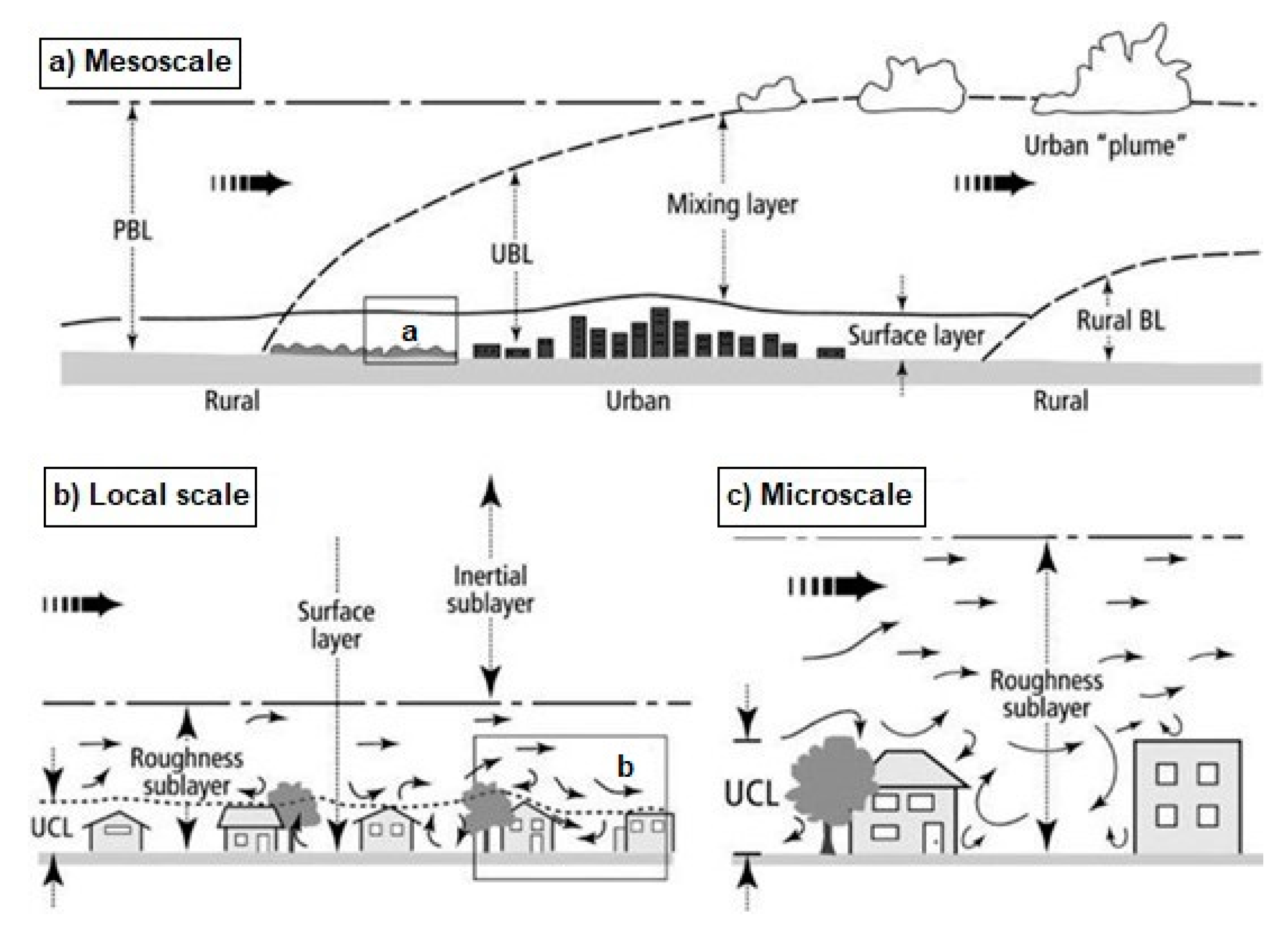
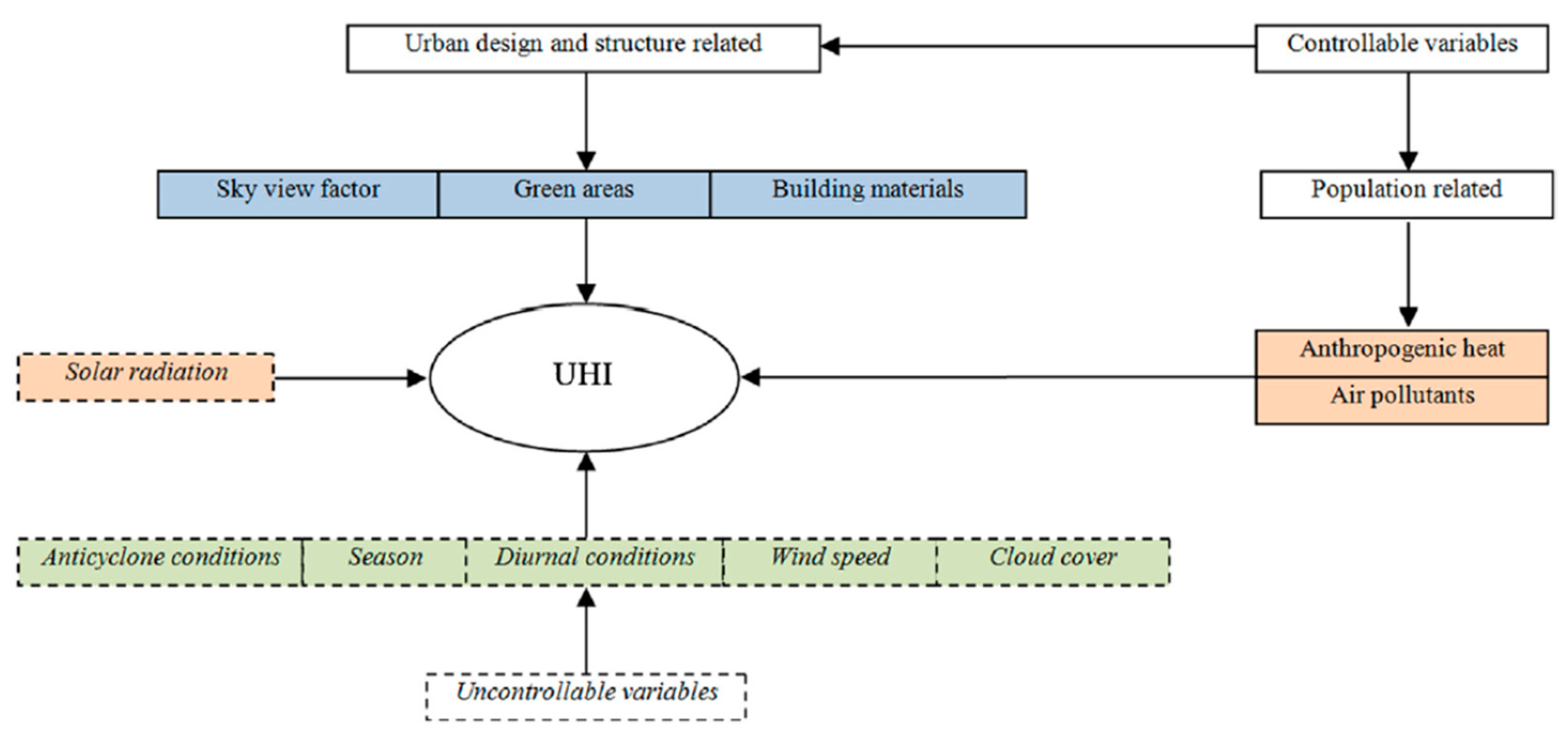
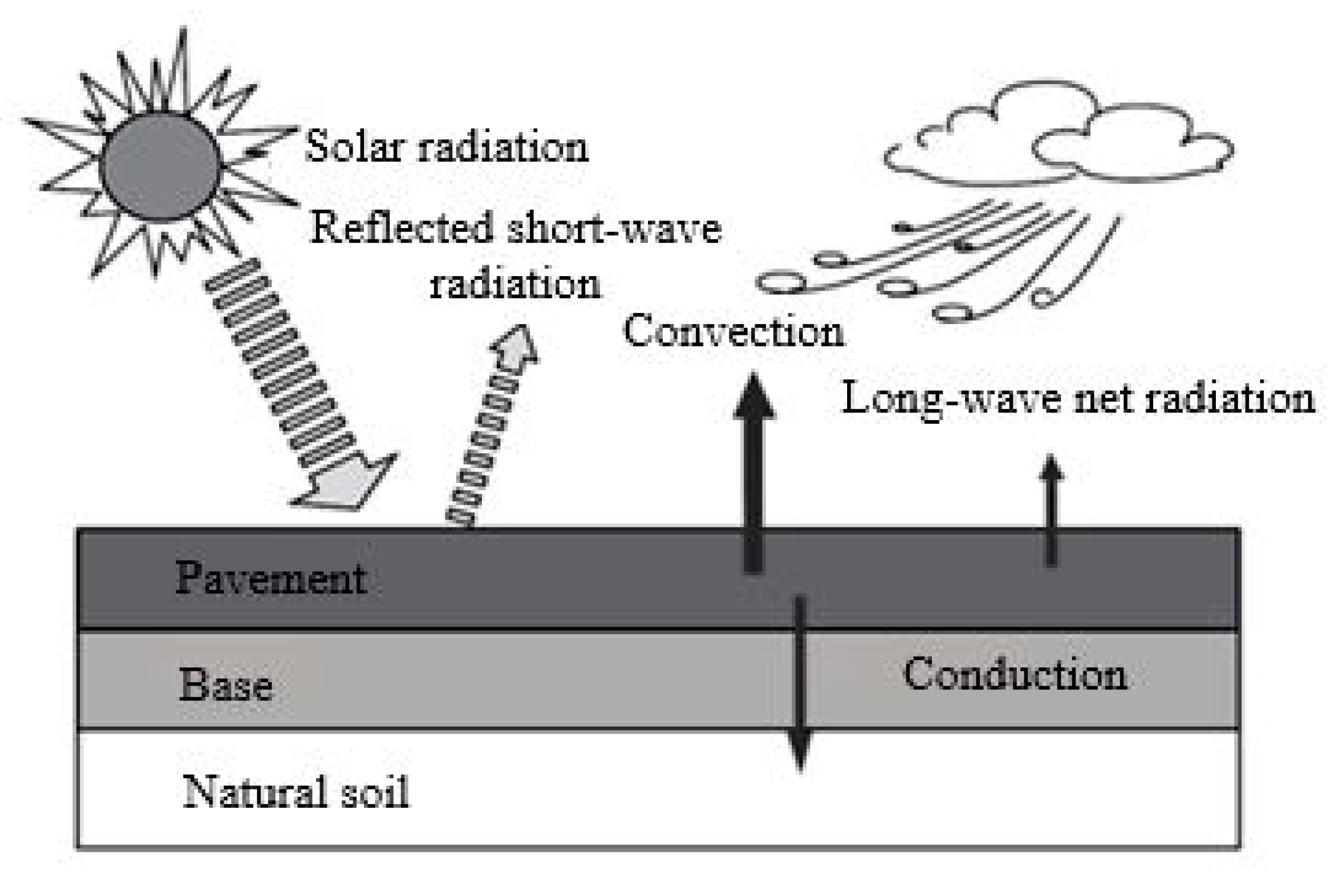
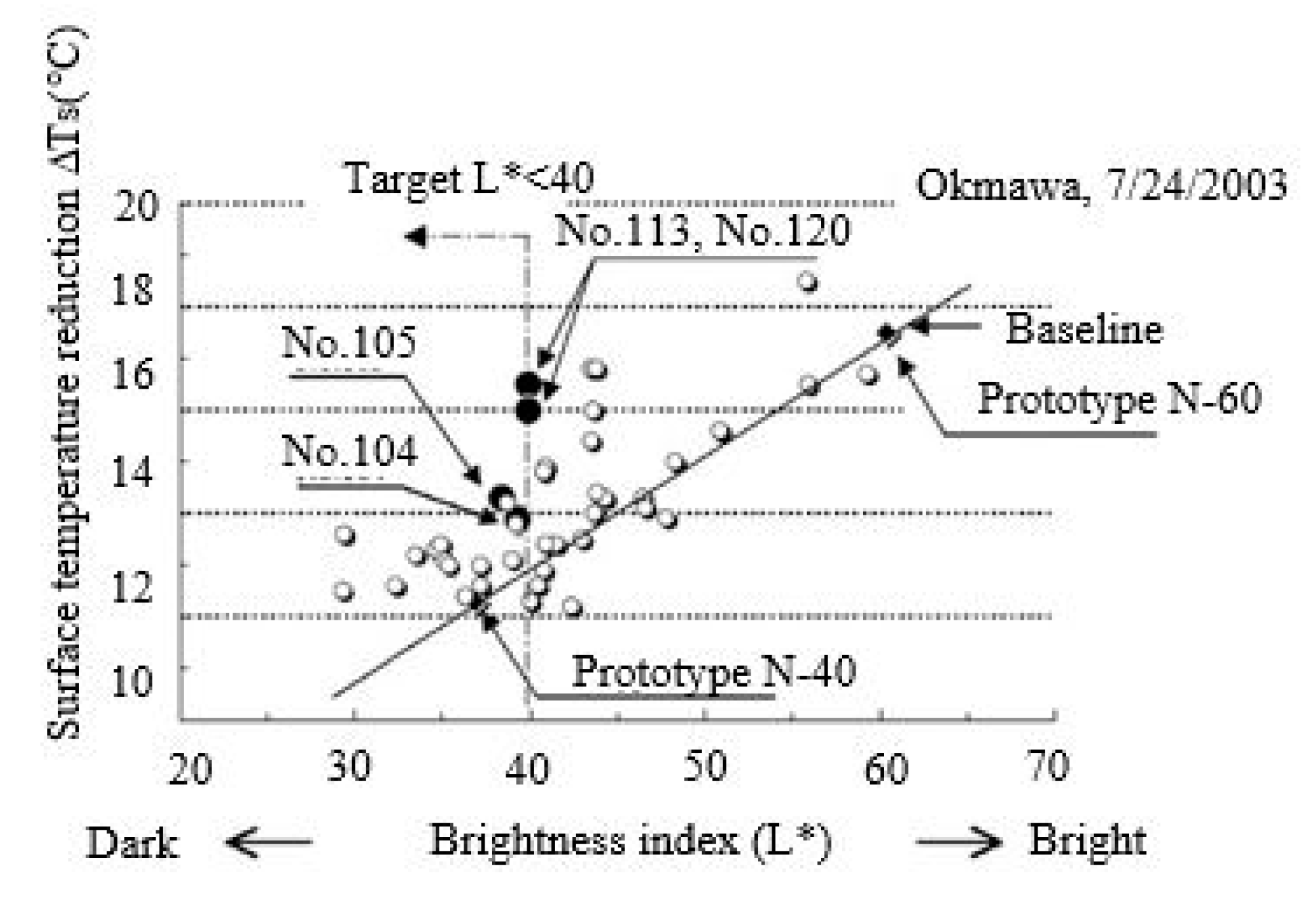


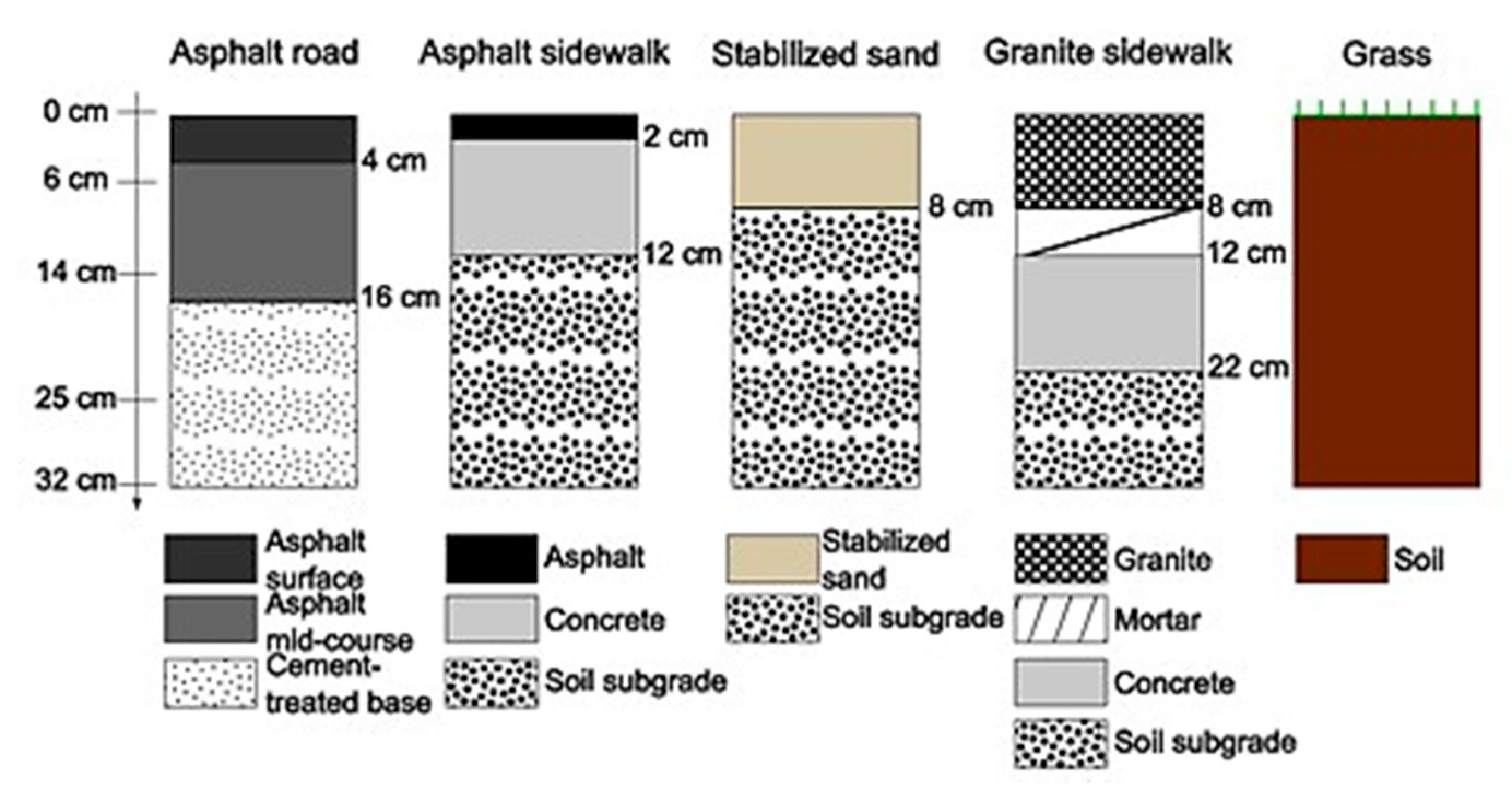

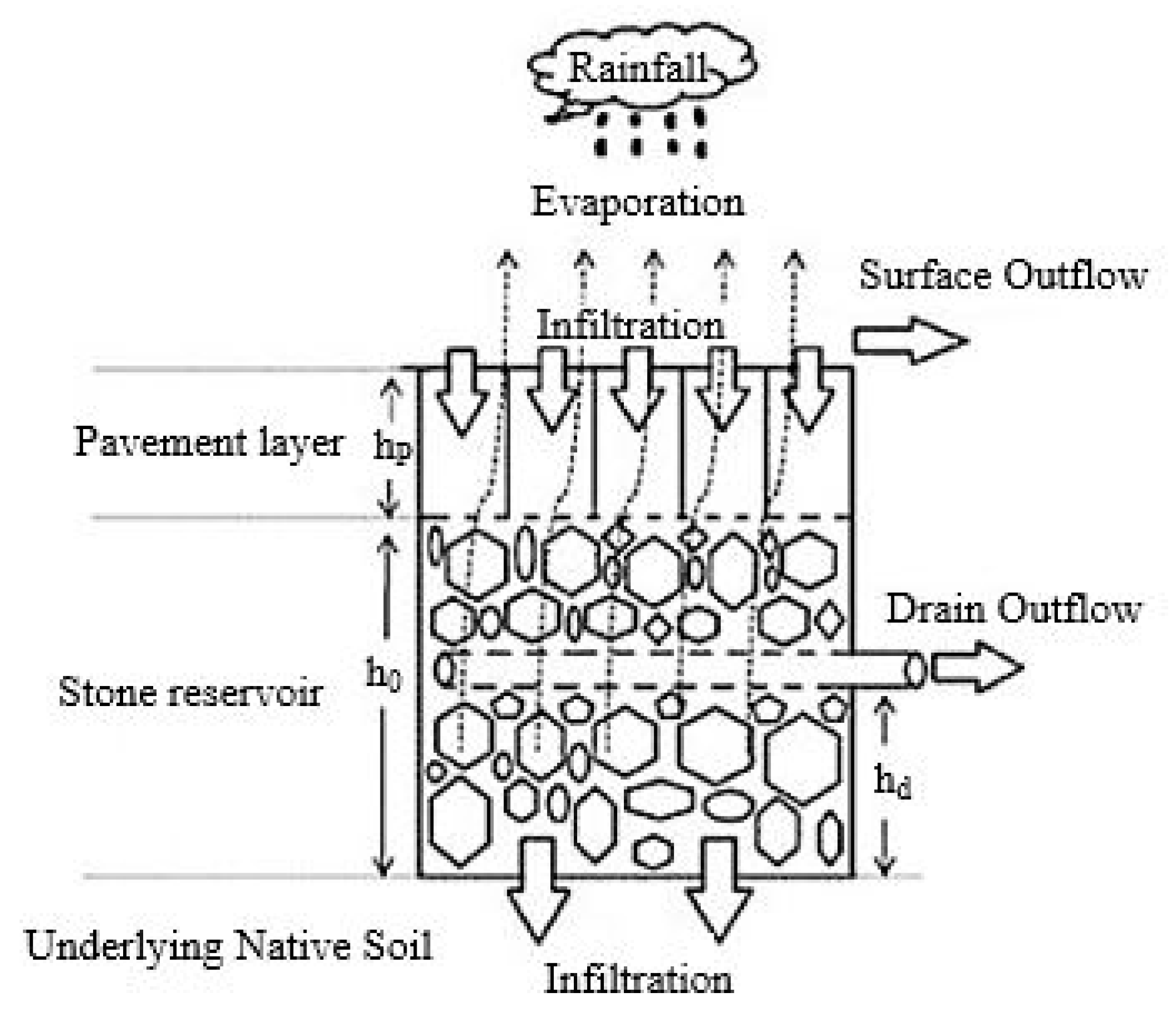
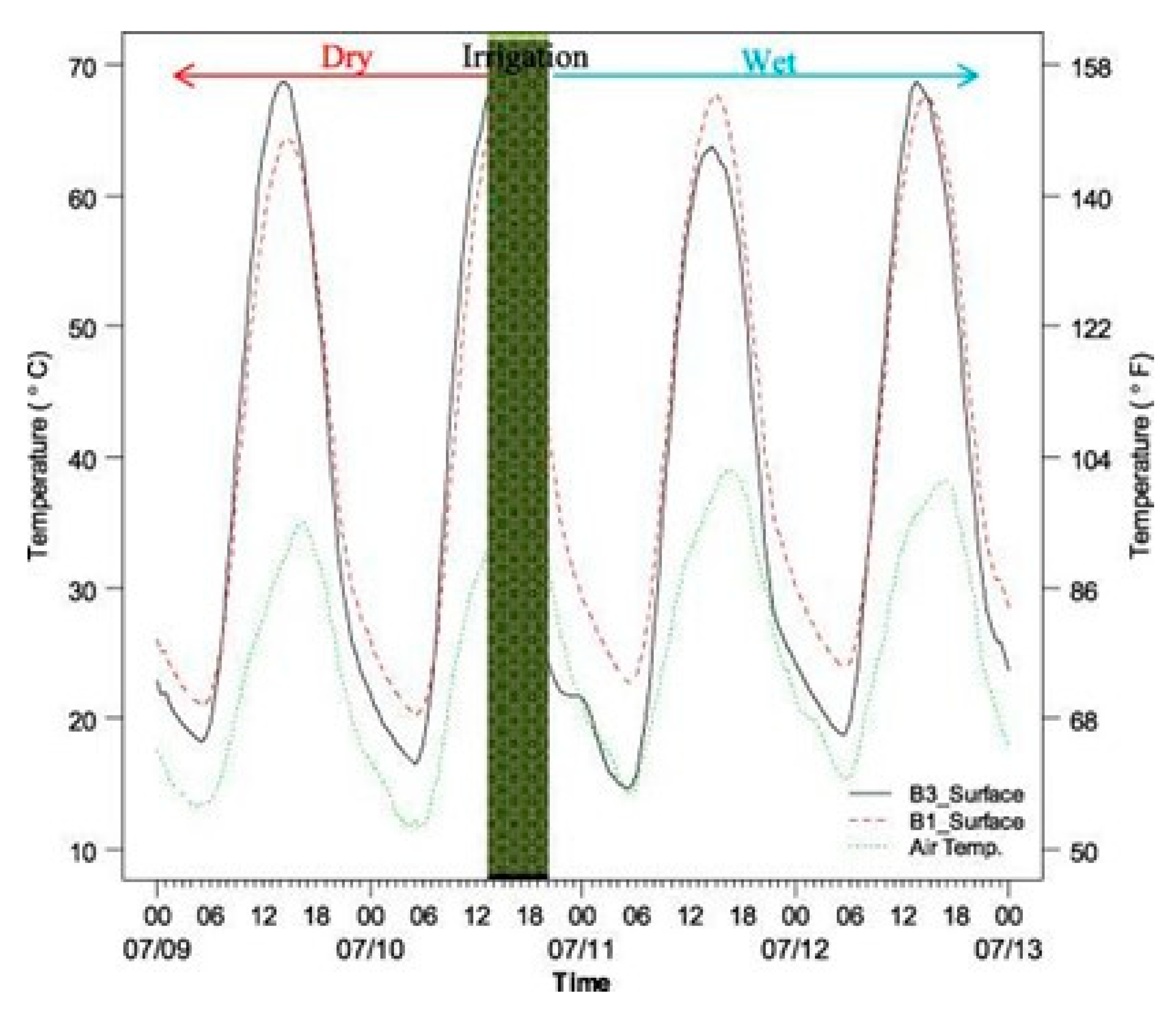
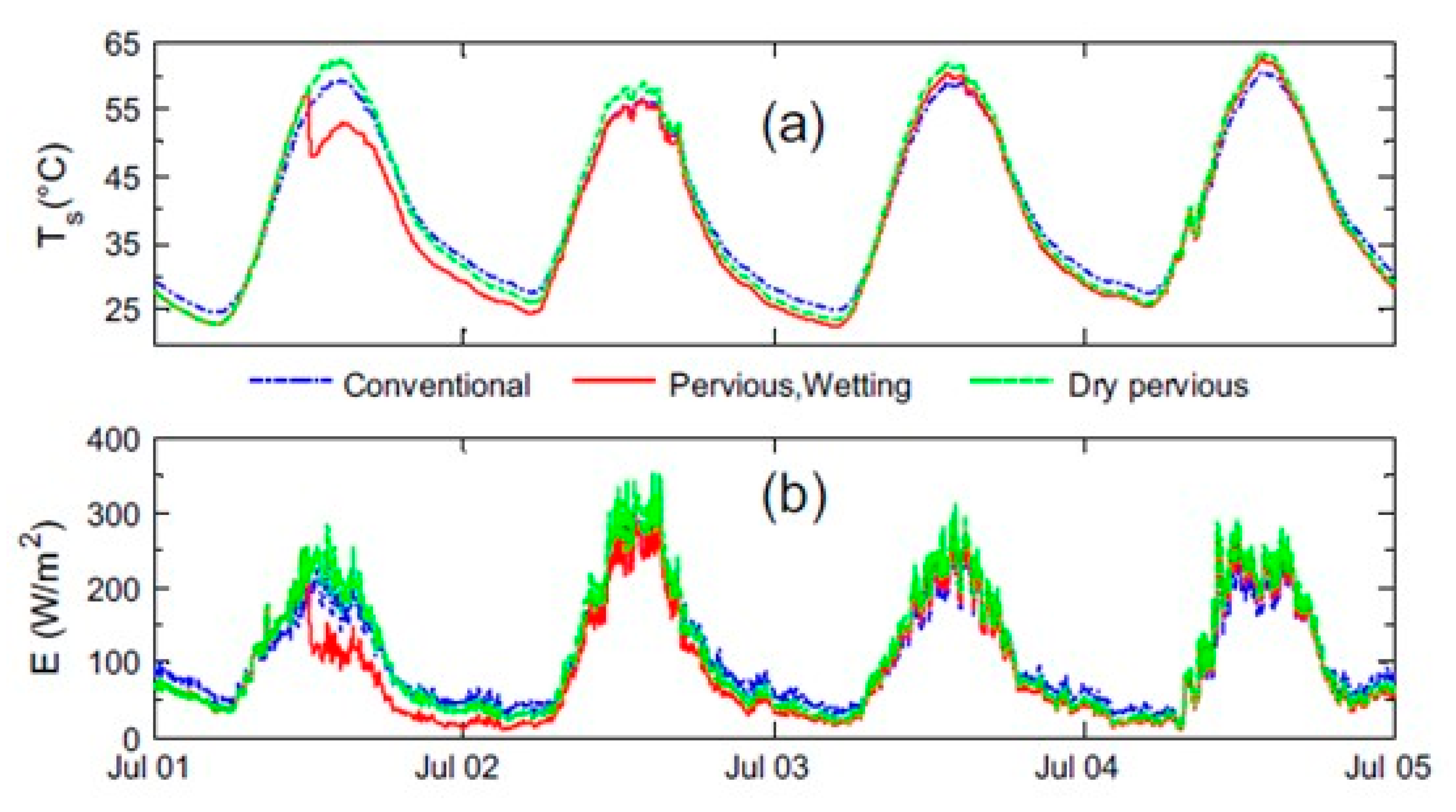
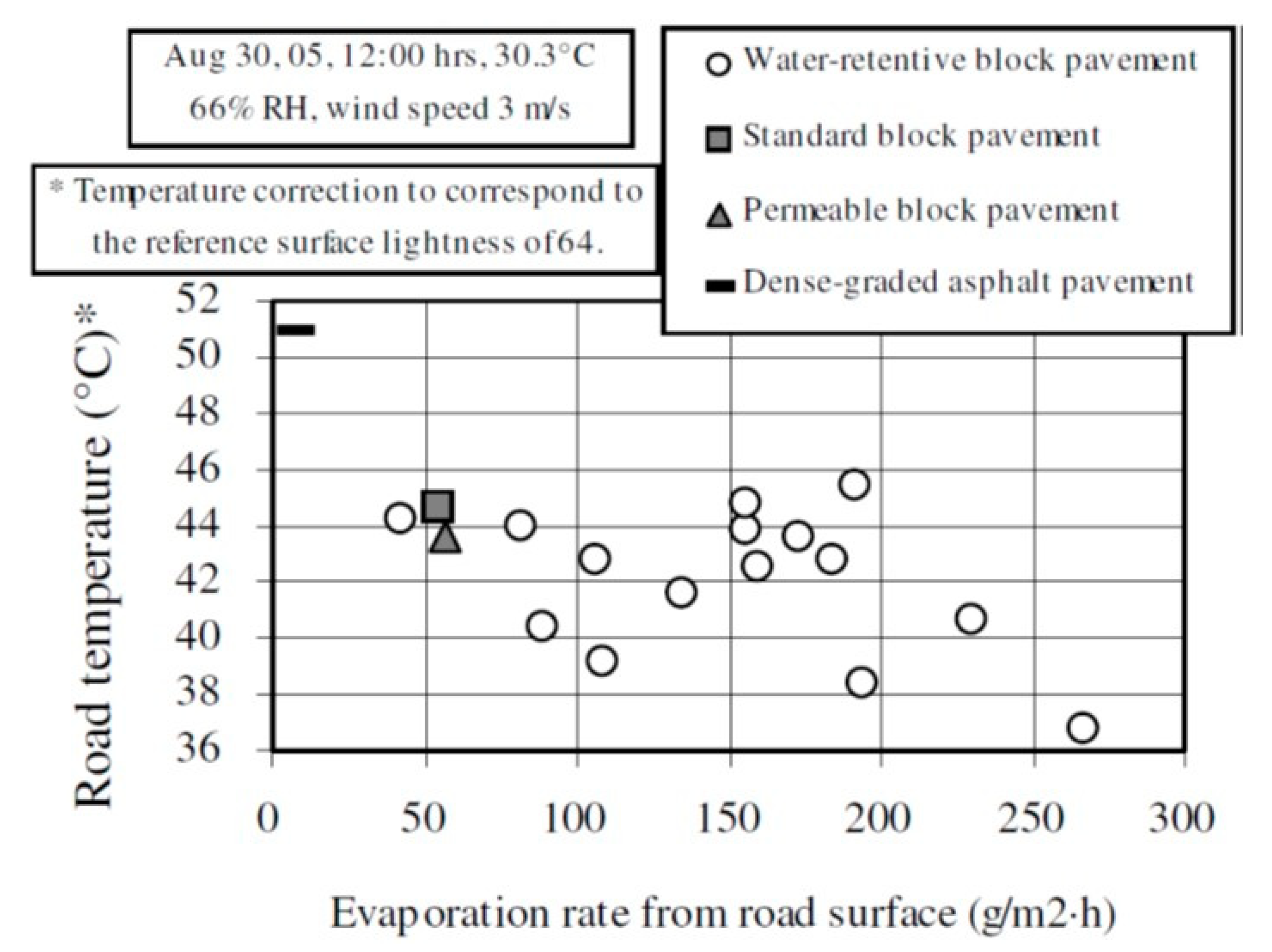
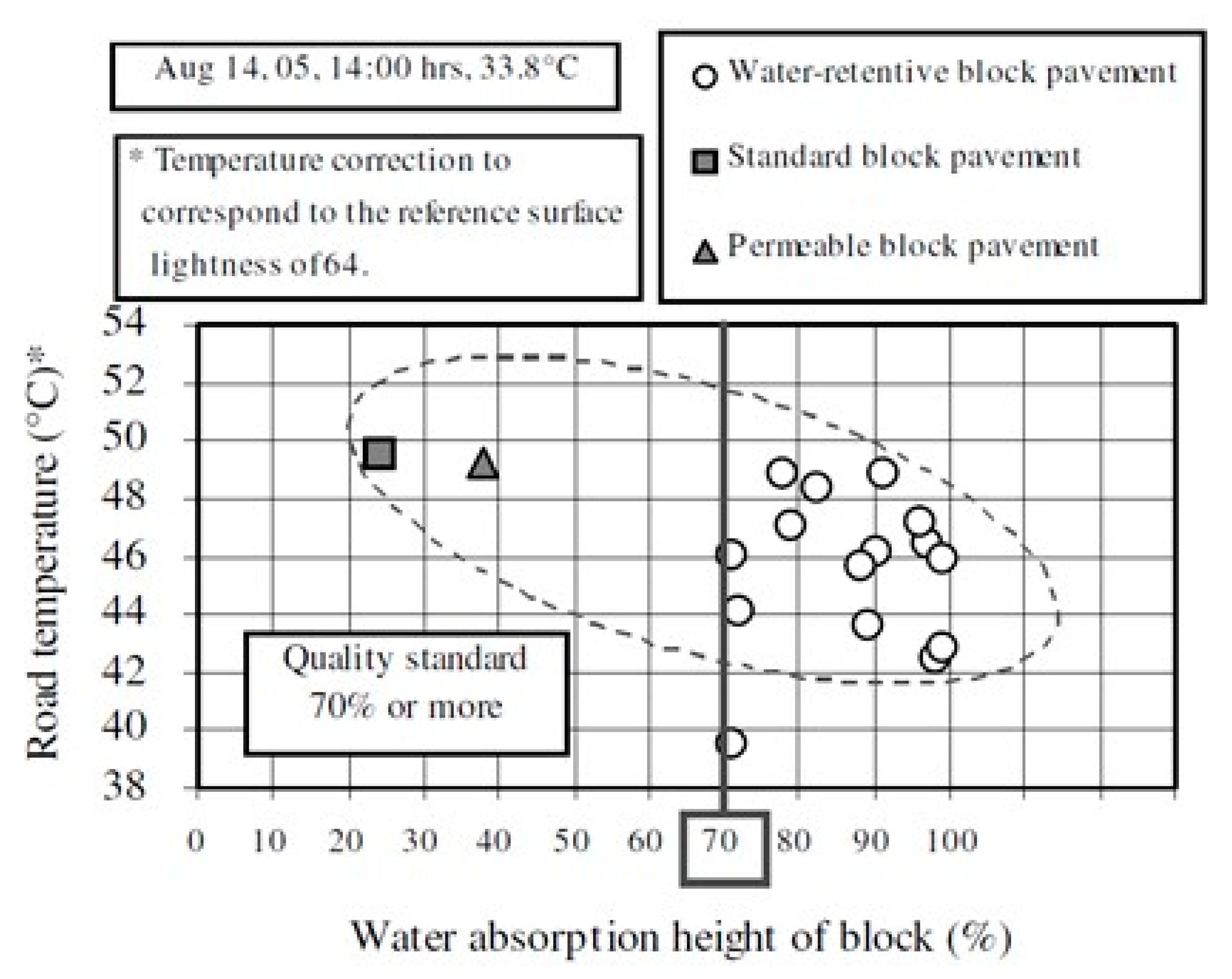
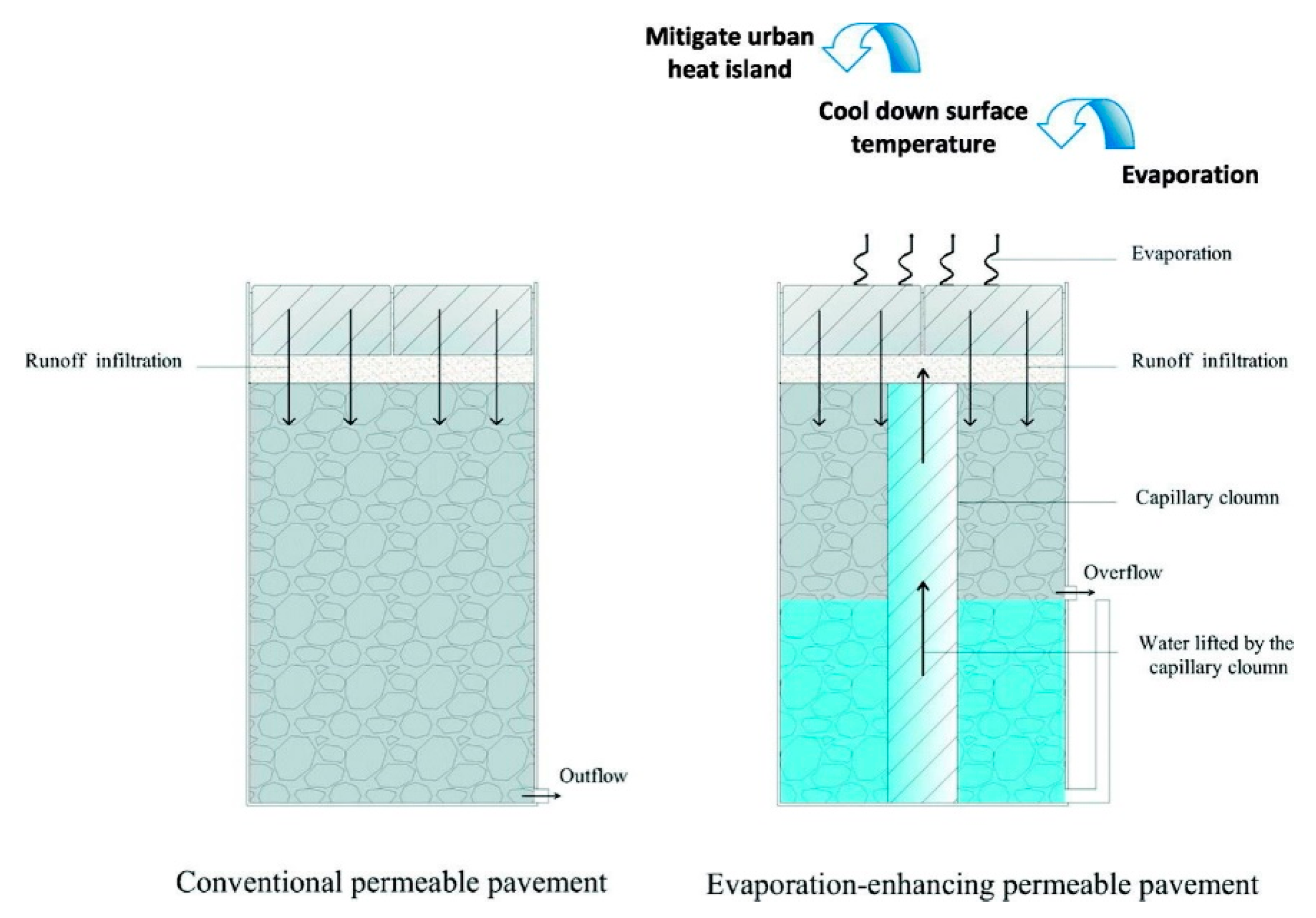
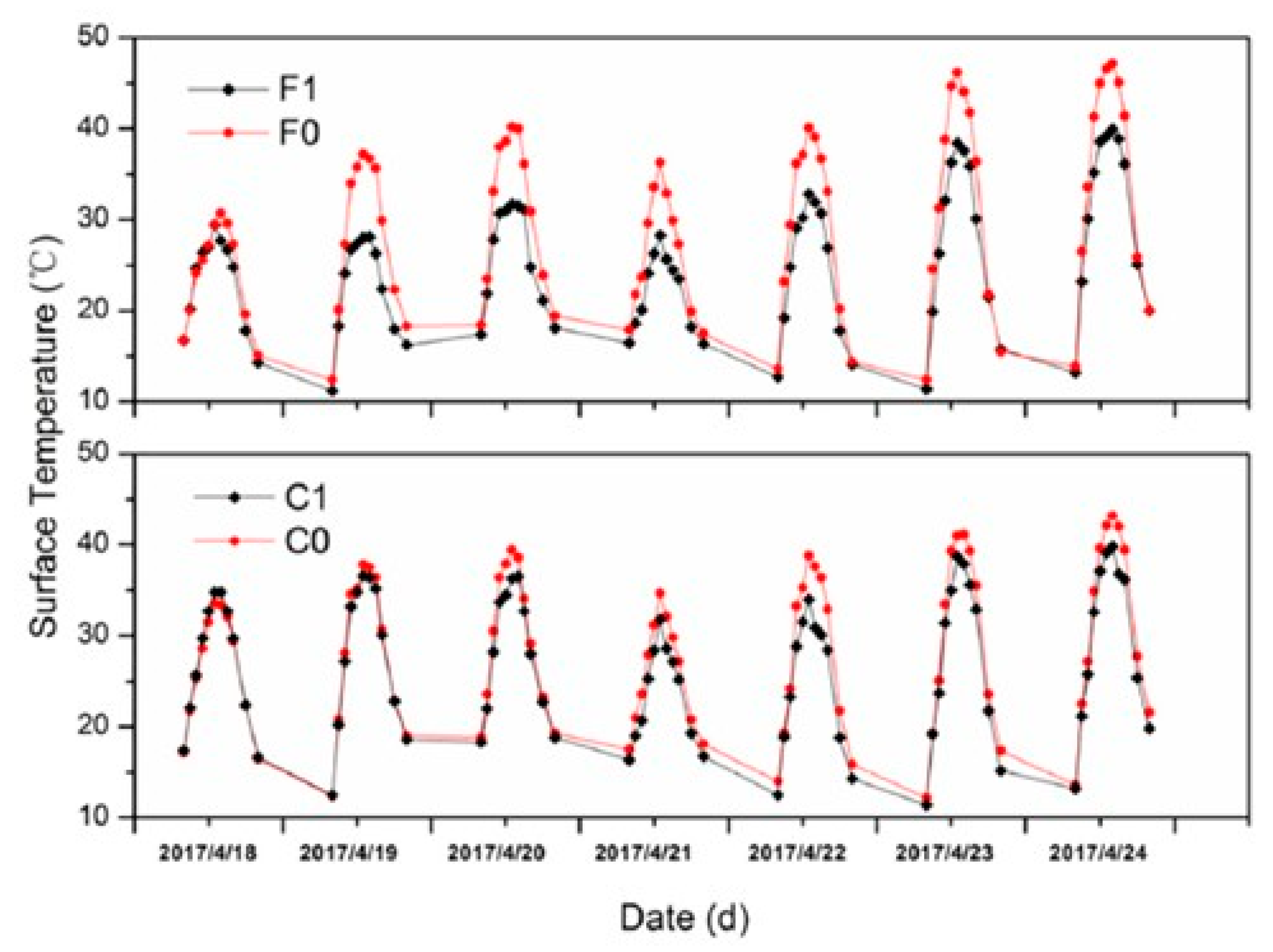
| Altered Energy Balance Terms Leading to a Positive Thermal Anomaly | Features of Urbanization Underlying Energy Balance Changes |
|---|---|
| A. Canopy layer | |
| 1. Increased absorption of short-wave radiation | Canyon geometry—increased surface area and multiple reflections |
| 2. Increased long-wave radiation from the sky | Air pollution—greater absorption and re-emission |
| 3. Decreased long-wave radiation loss | Canyon geometry—reduction of sky view factor |
| 4. Anthropogenic heat source | Building and traffic heat losses |
| 5. Increased sensible heat storage | Construction materials—increased thermal admittance |
| 6. Decreased evapotranspiration | Construction materials—increased imperviousness |
| 7. Decreased total turbulent heat transport | Canyon geometry—reduction of wind speed |
| B. Boundary layer | |
| 1. Increased absorption of short-wave radiation | Air pollution—increased aerosol absorption |
| 2. Anthropogenic heat source | Chimney and stack heat losses |
| 3. Increased sensible heat input-entrainment from below | Canopy heat island—increased heat flux from canopy layer and roofs |
| 4. Increased sensible heat input-entrainment from above | Heat island, roughness—increased turbulent Entrainment |
| Material (Dry State) | Remarks | Density (kg m−3 × 103) | Specific Heat (J kg−1 K−1 × 103) | Heat Capacity (J m−3K−1 × 106) | Thermal Conductivity (W m−1K−1) | Thermal Diffusivity (m2s−1 × 10−6) | Thermal Admittance (J m−2s−1/2) |
|---|---|---|---|---|---|---|---|
| Asphalt | 2.11 | 0.92 | 1.94 | 0.75 | 0.38 | 1205 | |
| Concrete | Aerated | 0.32 | 0.88 | 0.28 | 0.08 | 0.29 | 150 |
| Dense | 2.40 | 0.88 | 2.11 | 1.51 | 0.72 | 1785 | |
| Stone | Av. | 2.68 | 0.84 | 2.25 | 2.19 | 4.93 | 2220 |
| Brick | Av. | 1.83 | 0.75 | 1.37 | 0.83 | 0.61 | 1065 |
| Clay tiles | 1.92 | 0.92 | 1.77 | 0.84 | 0.47 | 1220 |
| Surface | Albedo | Emissivity |
|---|---|---|
| Asphalt | 0.125 | 0.95 |
| Concrete | 0.225 | 0.805 |
| Brick | 0.3 | 0.91 |
| Stone | 0.275 | 0.9 |
| Glass | 0.305 | 0.895 |
| Wood | 0.15 | 0.9 |
| Tile | 0.225 | 0.9 |
| Tar roof | 0.13 | 0.92 |
| Forest | 0.15 | 0.97 |
| Water | 0.5 | 0.97 |
Publisher’s Note: MDPI stays neutral with regard to jurisdictional claims in published maps and institutional affiliations. |
© 2021 by the authors. Licensee MDPI, Basel, Switzerland. This article is an open access article distributed under the terms and conditions of the Creative Commons Attribution (CC BY) license (https://creativecommons.org/licenses/by/4.0/).
Share and Cite
Vujovic, S.; Haddad, B.; Karaky, H.; Sebaibi, N.; Boutouil, M. Urban Heat Island: Causes, Consequences, and Mitigation Measures with Emphasis on Reflective and Permeable Pavements. CivilEng 2021, 2, 459-484. https://doi.org/10.3390/civileng2020026
Vujovic S, Haddad B, Karaky H, Sebaibi N, Boutouil M. Urban Heat Island: Causes, Consequences, and Mitigation Measures with Emphasis on Reflective and Permeable Pavements. CivilEng. 2021; 2(2):459-484. https://doi.org/10.3390/civileng2020026
Chicago/Turabian StyleVujovic, Svetlana, Bechara Haddad, Hamzé Karaky, Nassim Sebaibi, and Mohamed Boutouil. 2021. "Urban Heat Island: Causes, Consequences, and Mitigation Measures with Emphasis on Reflective and Permeable Pavements" CivilEng 2, no. 2: 459-484. https://doi.org/10.3390/civileng2020026
APA StyleVujovic, S., Haddad, B., Karaky, H., Sebaibi, N., & Boutouil, M. (2021). Urban Heat Island: Causes, Consequences, and Mitigation Measures with Emphasis on Reflective and Permeable Pavements. CivilEng, 2(2), 459-484. https://doi.org/10.3390/civileng2020026







